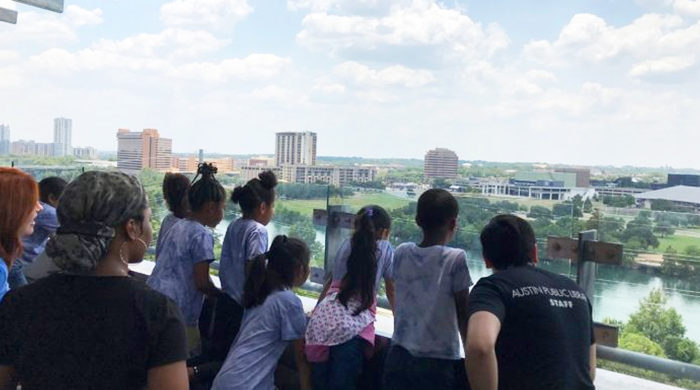The stunning Austin Central Library, already a finalist for the International Federation of Library Associations’ Public Library of the Year, leaped in prestige by winning LEED Platinum Building Certification this summer.
The award confirms that the space’s design and construction exemplify the utmost concern for human and environmental health. The library scored high marks for its green power, water-recycling systems, daylight use, views and community connectivity. Yet, we should feel challenged — not satisfied — by this last designation. Renewable-energy use, efficient landscaping and wastewater technologies are built-in, but considerable effort is still required to create real community connectivity. That is, the kind of bonds among people that exist beyond the realm of LEED’s neighborhood density and pedestrian access targets. We’ve built an impressive library, but what must we do to ensure that the people come? Not just avowed bookworms, architectural tourists, and downtown high-rise dwellers, but the broadest swath of our community possible?
Early indications are promising. The library staff, led by director Roosevelt Weeks, have stepped up efforts to welcome and wow diverse library visitors. I witnessed it recently when I accompanied a group of 30 black and Hispanic kids from the Children’s Defense Fund’s Freedom Schools summer program to the Central Library. Most of the kids hailed from underserved East Austin neighborhoods and hadn’t heard much about the library, let alone visited it.
Library staff greeted the bus and showed the awestruck guests every floor of the architectural wonder. In the special events area, the kids donned virtual reality headsets, learned to program tiny robots, experimented with electronic building blocks, and heard a story read by local author Willie S. Anderson. Staff also gave the students the low-down on getting books, homework help, and other resources through the library.
One small exchange exemplified the spirit of the visit.
“How many books do you think are in here?” a librarian asked, referring to the children’s section. The kids’ guesses ranged from 44 to millions. The truth was closer to 60,000.
“And who do they belong to?”
“The authors,” one shouted.
“The library,” another said.
“They belong to you,” she replied. “This collection belongs to you. Not just the books. The whole library. We just take care of them for you.”
The speaker, the statement, and the audience all struck me. I was happy to be present when the kids learned that libraries — even massive, glittering, “green” ones — are made for them. Though America’s public libraries have always professed a charge to serve all, they have a history of exclusion that mirrors that of the nation itself. Who counts as “the public” has been hotly contested. Witness the racial segregation laws that denied my maternal grandmother access to every branch in the Louisville Free Public Library system but one — the Western “colored” branch.
Years later, when my mother was born in 1946, less than a third of public library systems in the South reported serving African-Americans. That the majority couldn’t be bothered to provide even a bookmobile or segregated reading room conveys volumes.
For my mother, like her mother before, the Western branch in Louisville, Kentucky, was a haven. It spared her both the ignorance of having no library at all and the intimate indignity of entering the backdoors of white libraries to be confined to isolated colored reading rooms. The haven of that library helped her build the knowledge and skills that would carry her through graduate school and a career. At her retirement party, she quoted Walter Anderson, who said, “I read myself out of poverty long before I worked myself out of it.”
Everyone deserves that privilege. And in the Austin Central Library, standing with my own daughter, hearing a librarian’s declaration of inclusion, I saw a glimpse of the kind of community connectivity we should aspire to. It looks like caring people flinging the doors of our libraries wide open, intentionally ushering in new visitors, and making sure that they all feel at home.
Smart serves on the boards of the Austin Public Library Friends Foundation, the Texas Book Festival and the University of Texas Libraries Advisory Council.
Read full version here.


